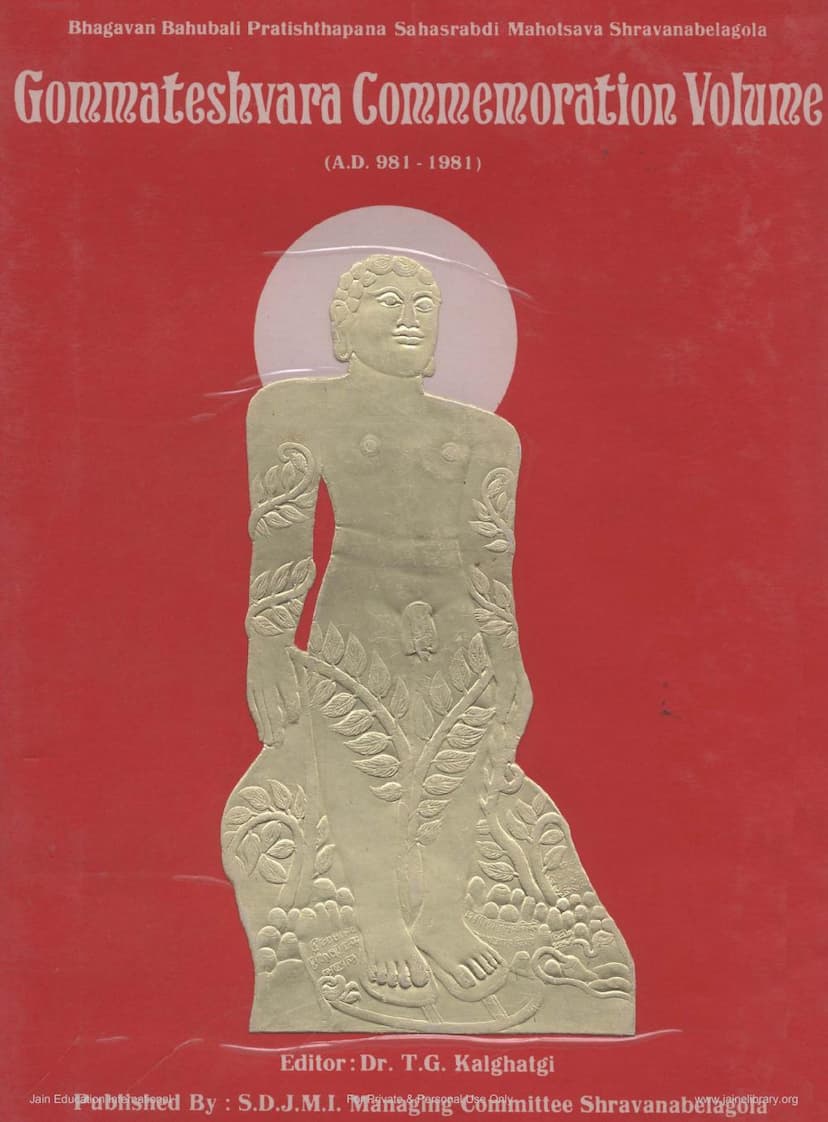Gommateshvara Commemoration Volume
Added to library: September 1, 2025

Summary
The Gommatesvara Commemoration Volume, published in 1981, commemorates the Mahamastakabhisheka (Great Head-Anointing Ceremony) of Bhagavan Bahubali at Shravanabelagola, marking one thousand years since the installation of the Gommatesvara statue. The volume features contributions from eminent scholars of Jainism and Indology, exploring various facets of Bhagavan Bahubali, Shravanabelagola, and Jainism.
Key Themes and Content:
-
Bhagavan Bahubali (Gommatesvara):
- Embodiment of Virtues: Bahubali is presented as the embodiment of ahimsa (non-violence), tyaga (self-denial), and tapas (penance). His story is seen as an enobling narrative that crystallizes qualities of self-sacrifice and human dignity.
- The Enigmatic Smile: The serene and enigmatic smile on the colossal statue's face is interpreted as conveying compassion, pity for the suffering world, and inner bliss.
- Spiritual Journey: Bahubali's renunciation of worldly pleasures after his duel with his brother Bharata, his subsequent austere penance, and eventual attainment of Kevala Jnana (omniscience) and Nirvana (liberation) are central to his narrative.
- Symbol of Detachment: His story symbolizes the importance of detachment from worldly possessions and the pursuit of spiritual excellence.
-
The Gommatesvara Statue:
- A Wonder of the World: The 57-foot monolithic granite statue at Shravanabelagola is consistently lauded as a wonder of the world, unparalleled in its grandeur, colossal size, and artistic execution.
- Masterpiece of Sculpture: The statue is admired for its perfect proportions, serene facial expression, and the artist's ability to imbue a stone colossus with such profound spiritual depth.
- Historical Significance: Erected in 981 A.D. by Chamundaraya, a minister of the Ganga dynasty, the statue marks a significant milestone in Indian art and sculpture, completing its thousandth year in 1981.
- Iconography: The nudity of the statue symbolizes absolute renunciation, while the intertwined creepers and ant-hills around its legs and hands depict the depth of Bahubali's penance.
-
Shravanabelagola:
- Ancient Jaina Pilgrimage Center: Shravanabelagola is highlighted as a significant religious, social, and cultural center of India, with a history dating back to the 3rd century B.C. when Bhadrabahu Swami and Chandragupta Maurya are believed to have arrived.
- Bhadrabahu and Chandragupta: The tradition of Bhadrabahu Svāmin bringing Jainism to South India and his sallekhana (ritual fasting unto death) on Chandragiri hill, along with his disciple Chandragupta Maurya, is discussed extensively. The article by Robert J. Zydenbos delves into the scholarly debate surrounding the historicity of this tradition.
- Sallekhana Inscriptions: The article by T. K. Tukol details numerous inscriptions at Shravanabelagola recording the practice of sallekhana by both ascetics and householders, underscoring the site's spiritual significance.
-
Jainism in Karnataka:
- Political Patronage: Jainism received significant royal patronage from dynasties like the Gangas, Kadambas, Rashtrakutas, and Hoysalas, who contributed to the spread of Jaina art, architecture, and literature in Karnataka.
- Anekanta and Ahimsa: The volume emphasizes the core Jaina principles of Anekanta (non-absolutism) and Ahimsa (non-violence) and their profound influence on Indian thought and culture. R. R. Diwakar's article, "Ahimsa Culture and Human Evolution," elaborates on the universal significance of ahimsa.
- Literary Contributions: The impact of Jainism on Kannada literature is explored, with specific mention of works like Pampa's Adipurana and Ratnakaravarni's Bharateshavaibhava. The article by B. S. Kulkarni highlights Bahubali's portrayal in Kannada literature.
- Artistic Heritage: The Jainas in Karnataka are noted for their austere yet profoundly expressive art forms, often lavishing intricate detail on temple interiors. The influence of Jaina art is seen in metal sculptures, illustrated manuscripts, and architectural marvels. Saryu Doshi's article, "Jaina Art in Karnataka: Some Examples," provides an overview of these artistic manifestations.
-
Bhattarakas: The article by Vilas Sangave discusses the Bhattāraka tradition, a unique religious authority within Digambara Jainism, its rise, extent, peculiarities, and contributions to culture, literature, and learning, particularly in Karnataka and Maharashtra.
-
Commentaries on Gommatasara: B. K. Khadabadi's article examines the commentaries on Acharya Nemichandra's influential work, Gommatasara, tracing the scholarly efforts to understand and disseminate Jaina philosophy.
In essence, the Gommatesvara Commemoration Volume serves as a comprehensive tribute to Bhagavan Bahubali and the enduring legacy of Jainism in India, particularly in Karnataka, celebrating a millennium of artistic and spiritual devotion embodied by the majestic statue at Shravanabelagola.